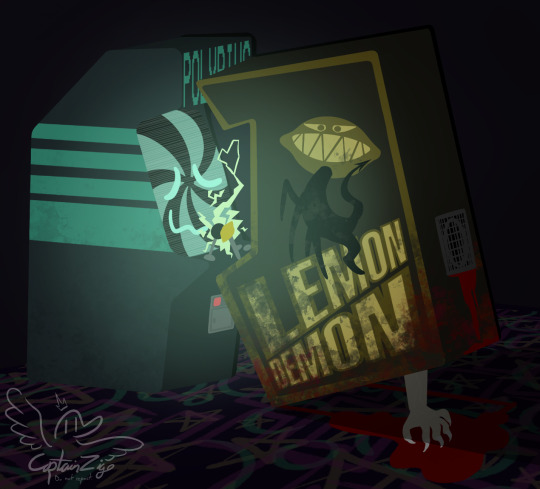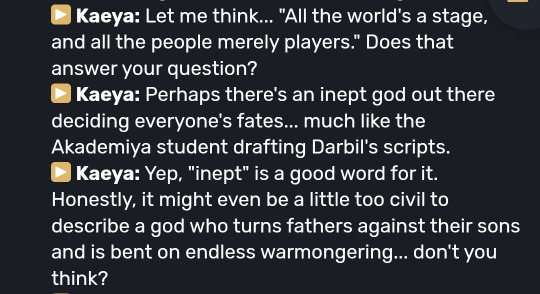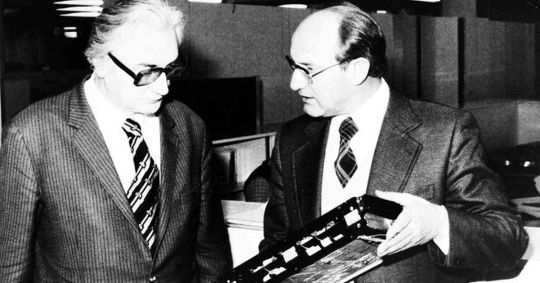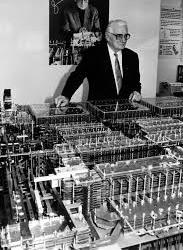#computability theory
Explore tagged Tumblr posts
Text
Le platonisme numérique : théorie de l'information et philosophie

L'espace calculant : Konrad Zuse
Konrad Zuse n'était pas seulement un ingénieur qui a construit le premier ordinateur complet de Turing et a donc inventé un appareil qui peut théoriquement résoudre n'importe quelle énigme mathématique soluble. Dans son livre Der Rechnende Raum de 1969, Zuse s'est également penché sur des questions philosophiques. Sa thèse principale est que la physique se trouve dans une impasse et ne peut pas résoudre de nombreuses questions parce qu'elle est soumise à une interprétation fondamentalement erronée du monde : on voit le monde de manière matérialiste. Pourtant, de nombreux phénomènes de la physique montrent que le matérialisme est probablement une erreur et que toute la matière n'est qu'une illusion. Selon Zuse, la réalité vraiment "réelle" est plutôt l'information.

Grâce à l'informatique, Zuse est ainsi arrivé à la même conclusion que Platon, Hegel et la plupart des religions. Dans son œuvre philosophique majeure Tractates Cryptica Scriptura, l'auteur de science-fiction Philip Kindred Dick est parvenu à une idée similaire d'association idéaliste de la religion et des mathématiques, sauf que sa déduction n'était pas les mathématiques et la physique, mais l'analyse comparative des écrits religieux. Des auteurs ultérieurs comme Rizwan Virk ont développé ces thèses et décrit que, grâce au concept de réseaux neuronaux, on devrait voir l'univers comme le produit d'un immense "esprit du monde" hégélien.
Loin des questions abstraites sur la cosmologie, la question se pose maintenant de savoir si l'on peut appliquer ces idées et ces modes de pensée à d'autres domaines de la philosophie. Et c'est possible. Et avec des résultats intéressants.
Le premier point intéressant est une question de prévisibilité. La prédictibilité décrit en gros les questions qu'un système donné peut "résoudre". La plupart du temps, il s'agit de machines concrètes. Mais les langues en font également partie. L'exhaustivité de Turing, déjà mentionnée au début, est ici particulièrement pertinente. Une machine de Turing est un appareil hypothétique composé d'un programme, d'une bande de mémoire et d'une "unité de lecture/écriture" mobile, qui peut calculer tous les problèmes calculables. En mathématiques, on considère qu'une question peut recevoir une réponse si on peut la formuler de manière à ce que cette machine fictive puisse la traiter. Ensuite, il y a la thèse de Church Turing, qui dit que du point de vue de la calculabilité, deux systèmes sont équivalents l'un à l'autre s'ils peuvent simuler mutuellement leur fonctionnement. (Pour illustrer cela de manière très simplifiée. Tout le monde ici peut télécharger la version des années 80 de Donkey Kong et la faire fonctionner sur son ordinateur portable normal, car la machine d'arcade sur laquelle fonctionnait Donkey Kong à l'époque et l'ordinateur portable actuel, sont fondamentalement tous deux des ordinateurs).
Et maintenant, le "point passionnant". Les hypothèses de simulation affirment que, parce que les ordinateurs peuvent simuler de mieux en mieux notre monde, il devient plus probable que le monde réel soit également une simulation calculée. Mais il y a encore un point qui a été négligé dans ces réflexions. Nous, les humains, avons d'abord conçu cette machine de Turing. Par conséquent, notre esprit est également soumis à ces lois. Nous sommes aussi Turing, voire plus puissants. Et nous comprenons de mieux en mieux l'univers et pouvons faire des prédictions et des calculs de plus en plus précis. Il existe donc un trait fondamental d'équivalence entre l'esprit créateur du monde et l'intellect humain. L'Esprit universel a créé l'homme à son image.

Il est toutefois évident qu'un seul esprit humain et un seul ordinateur ne peuvent pas résoudre toutes les questions de ce monde. C'est là qu'un autre élément entre en jeu. Il existe deux variantes de machines de Turing. Les machines universelles, qui peuvent tout calculer parce qu'elles ont une bande de mémoire infinie, et les machines de Turing limitées, qui sont limitées de manière finie. Et c'est la principale différence avec le "créateur". L'homme est fini (limité) et ne peut pas absorber toutes les informations.
Une bonne question est maintenant de savoir ce que signifie la technique pour l'homme. La technique est aussi souvent un moyen de stockage qui externalise l'information et la dissocie de l'esprit. Ce que l'homme ne peut pas mémoriser éternellement, il l'écrit afin de pouvoir le lire plus tard. Ainsi, la technique sert avant tout à élargir les capacités de mémoire de l'homme et à réduire la différence entre la machine de Turing limitée et la machine de Turing universelle. On pourrait ici utiliser la métaphore de Spengler sur "l'homme faustien" et dire que l'homme tente de se faire Dieu à l'aide de la technologie, en prenant le "fruit de l'arbre de la connaissance".
Un concept très similaire est l'idée de l'entropie de l'information et le concept associé du démon de Maxwell. L'entropie de l'information est, en gros, la valeur qui dit dans quelle mesure il est possible de reconstruire les infos manquantes à partir des informations existantes. Et quelle quantité peut manquer pour que quelque chose reste "lisible". Par exemple, on peut voir qu'il manque un S dans "Da ein". Là, l'entropie est faible. Mais pour "D n", l'entropie est si grande qu'il est difficile de deviner ce que l'on veut dire. L'entropie est donc aussi le degré d'incapacité à déduire ce qui vient ensuite à partir des connaissances existantes. L'entropie thermodynamique est considérée comme une conséquence de l'entropie de l'information. Dans un gaz chaud, tous les composants volent de manière chaotique. C'est pourquoi, à partir d'une image où tous les composants du gaz se trouvaient il y a 10 minutes, on ne peut pas vraiment déduire où ils se trouvent maintenant. Mais dans un cristal, c'est tout à fait possible, car tout y est rigide, immobile et ordonné. On pourrait dire ici que l'entropie est une valeur du chaos.
Selon l'entropie de l'information, il est également vrai que dans chaque système, l'entropie augmente inévitablement, l'information existante diminue et tout ordre est donc contraint de s'effondrer. Mais en même temps, le potentiel du type d'information qui pourrait exister augmente également [1] & [2]. Ce point est intéressant, car il correspond exactement à ce que Douguine a évoqué dans son texte La métaphysique du chaos: l'ordre est basé sur l'extinction ou l'exclusion du chaos. Or, le chaos permet l'émergence en son sein de différents ordres [3].
La théorie du démon de Maxwell est à son tour liée à l'entropie. Le démon de Maxwell est une machine hypothétique qui est placée sur un système chaotique (un gaz) et qui doit ordonner et trier les composants de ce système. Il est prouvé qu'un tel système ne peut pas fonctionner à long terme. Et cela parce que, entre autres, ce problème d'information potentielle fait que cette machine atteindrait ses limites de stockage. Le chaos ne pourrait être contrôlé durablement que si la machine disposait d'une mémoire infinie (voir les considérations ci-dessus à ce sujet). Comme la machine ne dispose pas d'une telle chose, le chaos devient à un moment donné si grand qu'il débouche sur une situation paradoxale où la machine doit elle-même créer le chaos et s'autodétruire lentement pour pouvoir se maintenir.
Ce démon de Maxwell se prête étonnamment bien à l'analyse de la modernité et du "cadre".
Chaque État moderne est en effet de facto un démon de Maxwell qui veut mettre fin à l'entropie et imposer l'ordre parfait. A commencer par les économies planifiées communistes, qui voulaient planifier les besoins des gens d'en haut. (Le sommet de cette évolution a été le Cybersyn de Salvador Allende - illustration ci-dessous-, où l'on voulait donner le contrôle d'une grande partie de l'État et de l'économie à un ordinateur central).

Le comportement de la troisième théorie politique et en particulier de l'Allemagne nazie avec l'eugénisme, les passeports généalogiques, les camps d'extermination, etc. peut être très fortement décrit comme une grande opération visant à éliminer le chaos, les impuretés et l'entropie, au détriment de la liberté, de l'humanité et de la vie humaine.
Les partisans de Popper vont maintenant prétendre que les sociétés libérales sont la protection contre de tels développements, mais cette propagande est une énorme tromperie. Voir le Patriot Act, les atrocités, l'oppression, l'expulsion et la rééducation des peuples indigènes au nom du colonialisme et du "fardeau de l'homme blanc", les guerres des néocons au nom de la démocratie, l'"État thérapeutique" envahissant qui veut éduquer les gens à la santé et contrôler sans cesse le citoyen dès l'enfance pour détecter les troubles de la santé, la Cancel Culture, la Political Correctness et d'autres formes de police de la pensée progressiste et antifasciste et de censure des réseaux, la surréglementation de l'UE, ainsi que de nombreux autres exemples. D'une certaine manière, les États libéraux poursuivent également l'eugénisme sous une forme privatisée grâce au Planned Parenthood et à d'autres initiatives. Et dans la crise du coronavirus, il existe désormais des certificats obligatoires de pureté biologique, même dans l'Occident libéral, et le thème des "camps pour impurs biologiques" revient régulièrement sous cette nouvelle forme. Voir l'Australie. (La principale différence entre le démon dans le libéralisme (2.0) et d'autres systèmes est qu'ici le démon est érigé comme un système qui inclut tout le monde et auquel personne ne doit refuser ou échapper, alors que d'autres systèmes étaient plutôt conçus pour refouler ou détruire les éléments chaotiques).
Quelle que soit la forme. Chaque théorie politique de la modernité et chaque État moderne est un démon maxwellien qui doit combattre toujours plus le chaos, au détriment de ses propres citoyens. D'une certaine manière, le démon maxwellien est aussi le noyau de la modernité, qui a été saisi par presque toutes les théories antimodernes. Qu'on l'appelle "Gestell" comme Heidegger, "Raison instrumentale" comme Adorno, "Société unidimensionnelle" comme Herbert Marcuse, "Règne de la quantité" comme René Guénon, "Intelligence solide" comme John C. Lilly ou autre. De Ted Kaczinsky à Rudolf Steiner en passant par Terence McKenna, tout concourt à démontrer que la modernité est un processus de mise en place d'une machine totale visant à éradiquer le chaos et menaçant d'éradiquer l'humanité. Et cela est presque perfectionné par des méthodes telles que les réseaux de neurones artificiels, la manipulation génétique, le transhumanisme, etc.
Seulement, comme nous l'avons déjà décrit, comme il n'existe pas de mémoire infinie, aucun démon maxwellien ne peut fonctionner à long terme. Tout ordre reste, pour le dire de manière bouddhiste, "annica", c'est-à-dire non durable, et menacé d'un effondrement permanent. L'entropie et le chaos ne sont pas éradiqués, mais seulement balayés sous le tapis à plus ou moins long terme. Et derrière les murs du monde ordonné de la modernité et dans son sous-sol, le chaos s'accumule jusqu'à ce qu'il fasse tomber les barrages. Le meilleur exemple en est le fait qu'en 2021, un bateau a eu un accident dans le canal de Suez, ce qui a failli déclencher une crise économique mondiale.
Seulement, selon le démon maxwellien, toute intervention des États modernes pour remédier au chaos ne fait qu'entraîner automatiquement plus de chaos et la nécessité d'autres interventions. (On pourrait appeler cela, avec Ludwig von Mises, la "spirale interventionniste").
Comment échapper à ce démon ? Probablement en regardant vers l'Orient et vers des enseignements comme le bouddhisme et le taoïsme, ainsi que l'école de Kyoto. Ces enseignements montrent très bien que tout finit par se désintégrer et que le but final de toute existence signifie à un moment donné le chaos, la désintégration et le néant absolu. Mais aussi que nous, les humains, ne pouvons pas vraiment lutter contre l'entropie, et que souvent une telle tentative ne fait qu'aggraver l'entropie. La seule solution est de prendre du recul par rapport à la matière et de se tourner vers des principes divins éternels et immuables. Comme l'éternel ne peut pas changer, l'entropie reste à zéro et ne peut pas se multiplier, car le double de zéro, par exemple, serait toujours zéro.
Notes:
[1] Voir https://www.uni-ulm.de/fileadmin/website_uni_ulm/archiv/haegele//Vorlesung/Grundlagen_II/_information.pdf page 6
[2] Un effet de l'entropie est également la dissolution de catégories strictement séparées et la fusion, vers une valeur moyenne. C'est le cas de la postmodernité.
[3] Voir également à ce sujet la citation suivante tirée de La métaphysique du chaos :
"Pour résoudre cette difficulté, nous devrions aborder le chaos non pas à partir de la position du logos, mais à partir de celle du chaos lui-même. Il peut être comparé à la vision féminine, à la compréhension féminine de l'autre, qui n'est pas exclue, mais au contraire incluse dans l'égalité.
Le logos se considère comme ce qui est et comme ce qui lui est égal. Il peut accepter les différences en lui parce qu'il exclut l'autre qui est à l'extérieur. C'est donc la volonté de puissance qui fonctionne, la loi de la souveraineté. Derrière le logos, affirme le logos, il n'y a rien, pas quelque chose. Les logos qui excluent tout autre qu'eux-mêmes excluent donc le chaos. Le chaos utilise une autre stratégie. Il inclut en lui tout ce qu'il est, mais en même temps aussi tout ce qu'il n'est p
Translator: Robert Steuckers
#philosophy#french#zuse#konrad zuse#simulation hypothesis#platonism#buddhism#information theory#calculating space#computer science#computability theory#automata theiry
4 notes
·
View notes
Text
Sam glancing through the window: Hey, he's back!
Danny: Crude. What's he doing now?
Sam: He's just standing there. Menacingly.
Tucker: What did you do to this ghost to have it follow you around dude?
Danny: I might have wandered into his Hunt by accident. But he didn't even have up a claim scent!
Sam: What kind of ghost doesn't mark their territory?
Danny: That's what I said. I tried to talk to him about it, but he wouldn't hear me out, even though it was an emergency.
Tucker: What emergency?
Danny: There was a mugging going on. The guy with the gun was getting violent and I think he was about to kill a kid so I stepped in. Now Vengeance won't leave me alone
Sam: Vengeance?
Danny pointing at the figure on the roof across the street: He literally said "I am Vengeance". Whenever he does a lighting strike hits the sky so I'm going to respect it.
Sam opening the window: Hey Vengeance! Get out of here! Yeah, I'm talking to you! You wannabe Goth! Go on, get!
Danny: Sam don't interact with him! Now he's going to follow me around more!
Tucker: He might even go from staring at you from the shadows to like talking to you.
Danny: *sigh* I knew this move was a dumb idea.
Tucker: Hey, how else would we get Wayne Enterprise to fund our computer systems? We're this close to creating the best thing to ever happen to Tech Geeks!
Sam: GO ON GET! GET OUT OF HERE! SHOO SHOO!
Danny: Sam!
#dcxdpdabbles#dc x dp crossover#from a fic i never wrote#The trio are doing a computer startup#Its Bruce's first year as Batman#He is confused by the pretty man who thinks hes a ghost#spirit halloween ship#People dont think Batman is real so this doesn't help Danny theory
2K notes
·
View notes
Text

祇想一生跟你走
Extra↓

I liked the artstyle (new favorite brush wahoo!!) just rlly unfortunate i didnt like pretty much everything about this piece :pp it did change alot compared to the draft didnt stick to the vision.. I lost sight of the grind
#This can be used as a desktop wallpaper if you wish#They still looked young ish in this art sorry bout that#If their clothing is innacurate i just haven't finish s8 AND I REFUSE#Keith did infact stole those from his garden what a romantic....#Clouds.. Again??#klance#voltron legendary defender#vld#vld fanart#voltron#voltron fanart#keith kogane#lance mcclain#IM FIGHTING SO HARD ON THE COLORS IM ABOUT TO JUMP MY COMPUTER#< never learnt color theory#pretend i posted this on 520 cause its cuter that way
520 notes
·
View notes
Text
There Were Always Enshittifiers

I'm on a 20+ city book tour for my new novel PICKS AND SHOVELS. Catch me in DC TONIGHT (Mar 4), and in RICHMOND TOMORROW (Mar 5). More tour dates here. Mail-order signed copies from LA's Diesel Books.

My latest Locus column is "There Were Always Enshittifiers." It's a history of personal computing and networked communications that traces the earliest days of the battle for computers as tools of liberation and computers as tools for surveillance, control and extraction:
https://locusmag.com/2025/03/commentary-cory-doctorow-there-were-always-enshittifiers/
The occasion for this piece is the publication of my latest Martin Hench novel, a standalone book set in the early 1980s called "Picks and Shovels":
https://us.macmillan.com/books/9781250865908/picksandshovels
The MacGuffin of Picks and Shovels is a "weird PC" company called Fidelity Computing, owned by a Mormon bishop, a Catholic priest, and an orthodox rabbi. It sounds like the setup for a joke, but the punchline is deadly serious: Fidelity Computing is a pyramid selling cult that preys on the trust and fellowship of faith groups to sell the dreadful Fidelity 3000 PC and its ghastly peripherals.
You see, Fidelity's products are booby-trapped. It's not merely that they ship with programs whose data-files can't be read by apps on any other system – that's just table stakes. Fidelity's got a whole bag of tricks up its sleeve – for example, it deliberately damages a specific sector on every floppy disk it ships. The drivers for its floppy drive initialize any read or write operation by checking to see if that sector can be read. If it can, the computer refuses to recognize the disk. This lets the Reverend Sirs (as Fidelity's owners style themselves) run a racket where they sell these deliberately damaged floppies at a 500% markup, because regular floppies won't work on the systems they lure their parishioners into buying.
Or take the Fidelity printer: it's just a rebadged Okidata ML-80, the workhorse tractor feed printer that led the market for years. But before Fidelity ships this printer to its customers, they fit it with new tractor feed sprockets whose pins are slightly more widely spaced than the standard 0.5" holes on the paper you can buy in any stationery store. That way, Fidelity can force its customers to buy the custom paper that they exclusively peddle – again, at a massive markup.
Needless to say, printing with these wider sprocket holes causes frequent jams and puts a serious strain on the printer's motors, causing them to burn out at a high rate. That's great news – for Fidelity Computing. It means they get to sell you more overpriced paper so you can reprint the jobs ruined by jams, and they can also sell you their high-priced, exclusive repair services when your printer's motors quit.
Perhaps you're thinking, "OK, but I can just buy a normal Okidata printer and use regular, cheap paper, right?" Sorry, the Reverend Sirs are way ahead of you: they've reversed the pinouts on their printers' serial ports, and a normal printer won't be able to talk to your Fidelity 3000.
If all of this sounds familiar, it's because these are the paleolithic ancestors of today's high-tech lock-in scams, from HP's $10,000/gallon ink to Apple and Google's mobile app stores, which cream a 30% commission off of every dollar collected by an app maker. What's more, these ancient, weird misfeatures have their origins in the true history of computing, which was obsessed with making the elusive, copy-proof floppy disk.
This Quixotic enterprise got started in earnest with Bill Gates' notorious 1976 "open letter to hobbyists" in which the young Gates furiously scolds the community of early computer hackers for its scientific ethic of publishing, sharing and improving the code that they all wrote:
https://en.wikipedia.org/wiki/An_Open_Letter_to_Hobbyists
Gates had recently cloned the BASIC programming language for the popular Altair computer. For Gates, his act of copying was part of the legitimate progress of technology, while the copying of his colleagues, who duplicated Gates' Altair BASIC, was a shameless act of piracy, destined to destroy the nascent computing industry:
As the majority of hobbyists must be aware, most of you steal your software. Hardware must be paid for, but software is something to share. Who cares if the people who worked on it get paid?
Needless to say, Gates didn't offer a royalty to John Kemeny and Thomas Kurtz, the programmers who'd invented BASIC at Dartmouth College in 1963. For Gates – and his intellectual progeny – the formula was simple: "When I copy you, that's progress. When you copy me, that's piracy." Every pirate wants to be an admiral.
For would-be ex-pirate admirals, Gates's ideology was seductive. There was just one fly in the ointment: computers operate by copying. The only way a computer can run a program is to copy it into memory – just as the only way your phone can stream a video is to download it to its RAM ("streaming" is a consensus hallucination – every stream is a download, and it has to be, because the internet is a data-transmission network, not a cunning system of tubes and mirrors that can make a picture appear on your screen without transmitting the file that contains that image).
Gripped by this enshittificatory impulse, the computer industry threw itself headfirst into the project of creating copy-proof data, a project about as practical as making water that's not wet. That weird gimmick where Fidelity floppy disks were deliberately damaged at the factory so the OS could distinguish between its expensive disks and the generic ones you bought at the office supply place? It's a lightly fictionalized version of the copy-protection system deployed by Visicalc, a move that was later publicly repudiated by Visicalc co-founder Dan Bricklin, who lamented that it confounded his efforts to preserve his software on modern systems and recover the millions of data-files that Visicalc users created:
http://www.bricklin.com/robfuture.htm
The copy-protection industry ran on equal parts secrecy and overblown sales claims about its products' efficacy. As a result, much of the story of this doomed effort is lost to history. But back in 2017, a redditor called Vadermeer unearthed a key trove of documents from this era, in a Goodwill Outlet store in Seattle:
https://www.reddit.com/r/VintageApple/comments/5vjsow/found_internal_apple_memos_about_copy_protection/
Vaderrmeer find was a Apple Computer binder from 1979, documenting the company's doomed "Software Security from Apple's Friends and Enemies" (SSAFE) project, an effort to make a copy-proof floppy:
https://archive.org/details/AppleSSAFEProject
The SSAFE files are an incredible read. They consist of Apple's best engineers beavering away for days, cooking up a new copy-proof floppy, which they would then hand over to Apple co-founder and legendary hardware wizard Steve Wozniak. Wozniak would then promptly destroy the copy-protection system, usually in a matter of minutes or hours. Wozniak, of course, got the seed capital for Apple by defeating AT&T's security measures, building a "blue box" that let its user make toll-free calls and peddling it around the dorms at Berkeley:
https://512pixels.net/2018/03/woz-blue-box/
Woz has stated that without blue boxes, there would never have been an Apple. Today, Apple leads the charge to restrict how you use your devices, confining you to using its official app store so it can skim a 30% vig off every dollar you spend, and corralling you into using its expensive repair depots, who love to declare your device dead and force you to buy a new one. Every pirate wants to be an admiral!
https://www.vice.com/en/article/tim-cook-to-investors-people-bought-fewer-new-iphones-because-they-repaired-their-old-ones/
Revisiting the early PC years for Picks and Shovels isn't just an excuse to bust out some PC nostalgiacore set-dressing. Picks and Shovels isn't just a face-paced crime thriller: it's a reflection on the enshittificatory impulses that were present at the birth of the modern tech industry.
But there is a nostalgic streak in Picks and Shovels, of course, represented by the other weird PC company in the tale. Computing Freedom is a scrappy PC startup founded by three women who came up as sales managers for Fidelity, before their pangs of conscience caused them to repent of their sins in luring their co-religionists into the Reverend Sirs' trap.
These women – an orthodox lesbian whose family disowned her, a nun who left her order after discovering the liberation theology movement, and a Mormon woman who has quit the church over its opposition to the Equal Rights Amendment – have set about the wozniackian project of reverse-engineering every piece of Fidelity hardware and software, to make compatible products that set Fidelity's caged victims free.
They're making floppies that work with Fidelity drives, and drives that work with Fidelity's floppies. Printers that work with Fidelity computers, and adapters so Fidelity printers will work with other PCs (as well as resprocketing kits to retrofit those printers for standard paper). They're making file converters that allow Fidelity owners to read their data in Visicalc or Lotus 1-2-3, and vice-versa.
In other words, they're engaged in "adversarial interoperability" – hacking their own fire-exits into the burning building that Fidelity has locked its customers inside of:
https://www.eff.org/deeplinks/2019/10/adversarial-interoperability
This was normal, back then! There were so many cool, interoperable products and services around then, from the Bell and Howell "Black Apple" clones:
https://forum.vcfed.org/index.php?threads%2Fbell-howell-apple-ii.64651%2F
to the amazing copy-protection cracking disks that traveled from hand to hand, so the people who shelled out for expensive software delivered on fragile floppies could make backups against the inevitable day that the disks stopped working:
https://en.wikipedia.org/wiki/Bit_nibbler
Those were wild times, when engineers pitted their wits against one another in the spirit of Steve Wozniack and SSAFE. That era came to a close – but not because someone finally figured out how to make data that you couldn't copy. Rather, it ended because an unholy coalition of entertainment and tech industry lobbyists convinced Congress to pass the Digital Millennium Copyright Act in 1998, which made it a felony to "bypass an access control":
https://www.eff.org/deeplinks/2016/07/section-1201-dmca-cannot-pass-constitutional-scrutiny
That's right: at the first hint of competition, the self-described libertarians who insisted that computers would make governments obsolete went running to the government, demanding a state-backed monopoly that would put their rivals in prison for daring to interfere with their business model. Plus ça change: today, their intellectual descendants are demanding that the US government bail out their "anti-state," "independent" cryptocurrency:
https://www.citationneeded.news/issue-78/
In truth, the politics of tech has always contained a faction of "anti-government" millionaires and billionaires who – more than anything – wanted to wield the power of the state, not abolish it. This was true in the mainframe days, when companies like IBM made billions on cushy defense contracts, and it's true today, when the self-described "Technoking" of Tesla has inserted himself into government in order to steer tens of billions' worth of no-bid contracts to his Beltway Bandit companies:
https://www.reuters.com/world/us/lawmakers-question-musk-influence-over-verizon-faa-contract-2025-02-28/
The American state has always had a cozy relationship with its tech sector, seeing it as a way to project American soft power into every corner of the globe. But Big Tech isn't the only – or the most important – US tech export. Far more important is the invisible web of IP laws that ban reverse-engineering, modding, independent repair, and other activities that defend American tech exports from competitors in its trading partners.
Countries that trade with the US were arm-twisted into enacting laws like the DMCA as a condition of free trade with the USA. These laws were wildly unpopular, and had to be crammed through other countries' legislatures:
https://pluralistic.net/2024/11/15/radical-extremists/#sex-pest
That's why Europeans who are appalled by Musk's Nazi salute have to confine their protests to being loudly angry at him, selling off their Teslas, and shining lights on Tesla factories:
https://www.malaymail.com/news/money/2025/01/24/heil-tesla-activists-protest-with-light-projection-on-germany-plant-after-musks-nazi-salute-video/164398
Musk is so attention-hungry that all this is as apt to please him as anger him. You know what would really hurt Musk? Jailbreaking every Tesla in Europe so that all its subscription features – which represent the highest-margin line-item on Tesla's balance-sheet – could be unlocked by any local mechanic for €25. That would really kick Musk in the dongle.
The only problem is that in 2001, the US Trade Rep got the EU to pass the EU Copyright Directive, whose Article 6 bans that kind of reverse-engineering. The European Parliament passed that law because doing so guaranteed tariff-free access for EU goods exported to US markets.
Enter Trump, promising a 25% tariff on European exports.
The EU could retaliate here by imposing tit-for-tat tariffs on US exports to the EU, which would make everything Europeans buy from America 25% more expensive. This is a very weird way to punish the USA.
On the other hand, not that Trump has announced that the terms of US free trade deals are optional (for the US, at least), there's no reason not to delete Article 6 of the EUCD, and all the other laws that prevent European companies from jailbreaking iPhones and making their own App Stores (minus Apple's 30% commission), as well as ad-blockers for Facebook and Instagram's apps (which would zero out EU revenue for Meta), and, of course, jailbreaking tools for Xboxes, Teslas, and every make and model of every American car, so European companies could offer service, parts, apps, and add-ons for them.
When Jeff Bezos launched Amazon, his war-cry was "your margin is my opportunity." US tech companies have built up insane margins based on the IP provisions required in the free trade treaties it signed with the rest of the world.
It's time to delete those IP provisions and throw open domestic competition that attacks the margins that created the fortunes of oligarchs who sat behind Trump on the inauguration dais. It's time to bring back the indomitable hacker spirit that the Bill Gateses of the world have been trying to extinguish since the days of the "open letter to hobbyists." The tech sector built a 10 foot high wall around its business, then the US government convinced the rest of the world to ban four-metre ladders. Lift the ban, unleash the ladders, free the world!
In the same way that futuristic sf is really about the present, Picks and Shovels, an sf novel set in the 1980s, is really about this moment.
I'm on tour with the book now – if you're reading this today (Mar 4) and you're in DC, come see me tonight with Matt Stoller at 6:30PM at the Cleveland Park Library:
https://www.loyaltybookstores.com/picksnshovels
And if you're in Richmond, VA, come down to Fountain Bookshop and catch me with Lee Vinsel tomorrow (Mar 5) at 7:30PM:
https://fountainbookstore.com/events/1795820250305

If you'd like an essay-formatted version of this post to read or share, here's a link to it on pluralistic.net, my surveillance-free, ad-free, tracker-free blog:
https://pluralistic.net/2025/03/04/object-permanence/#picks-and-shovels
#pluralistic#picks and shovels#history#web theory#marty hench#martin hench#red team blues#locus magazine#drm#letter to computer hobbyists#bill gates#computer lib#science fiction#crime fiction#detective fiction
498 notes
·
View notes
Text

toxic arcade cabinet yaoi
#polybius#lemon demon#cabinet man#toxic yaoi#arcade cabinet#retro tech#arcade#objectum#computer objectum#selfcest#cryptid#conspiracy theories#urban legends#mk ultra#arcadecore#arcade carpet#sinneslöschen#sonneslochen#objectophilia#sci fi art#christmas eve#spirit phone#conspiracy theory#urban legend#creepypasta#niel cicierega#mind control#80s tech#crt#video games
375 notes
·
View notes
Text
In the twentieth century, few would have ever defined a truck driver as a ‘cognitive worker’, an intellectual. In the early twenty-first, however, the application of artificial intelligence (AI) in self-driving vehicles, among other artefacts, has changed the perception of manual skills such as driving, revealing how the most valuable component of work in general has never been just manual, but has always been cognitive and cooperative as well. Thanks to AI research – we must acknowledge it – truck drivers have reached the pantheon of intelligentsia. It is a paradox – a bitter political revelation – that the most zealous development of automation has shown how much ‘intelligence’ is expressed by activities and jobs that are usually deemed manual and unskilled, an aspect that has often been neglected by labour organisation as much as critical theory.
– Matteo Pasquinelli, The Eye of the Master: A Social History of Artificial Intelligence (2023)
#Matteo Pasquinelli#The Eye of the Master#Social History#Social theory#AI#Artificial Intelligence#Science#Scientism#Labour#Capitalism#Marxism#Malaise#Computer Science#Technology#Words#Quote#Writing#Text#Reading#Books#⏳
159 notes
·
View notes
Text
bro wdym the Pope was a math major from Villanova in undergrad im crying TT TT TT what is the catholic church's official stance on P vs NP please i have a theory of comp exam, can he just, like, announce that P=NP pleaseeeeee
121 notes
·
View notes
Text



Asgore. What. Have. You. Been. Doing?
#deltarune spoilers#deltarune chapters 3 & 4 spoilers#deltarune chapter spoilers#asgore dreemurr#deltarune theory#not a Knight theory#I think he did make the dark fountains in the computer lab and the church#deltarune chapters 3 & 4#deltarune
83 notes
·
View notes
Text
Something about what Venti said


Doesn't this sound familiar?
Oh, right. Kaeya.

Kaeya, in his hangout quest to be specific.


and finally

#yes im posting another one. this kept me up at night so i might as well#my company computer is booting up as i type this out#and that is the level of multitasking im doing for kaeya theory#text heavy images#kaeya#kaeya alberich#gi kaeya#kaeya theory#genshin theory#wait does this even count as a theory? im just pointing this out lmao#oh my pc is booted bye just tell me if i need to add more tags#genshin impact 5.6#gi 5.6 spoilers#genshin spoilers
72 notes
·
View notes
Text
Konrad Zuse und der Z3: Vor 80 Jahren erfand ein Deutscher den ersten Computer

Auf den Tag genau vor 80 Jahren stellte Konrad Zuse der Welt den ersten Computer vor. Was viele nicht wissen: Der Berliner Ingenieur veröffentlichte auch philosophische Schriften, die auf technisch-naturwissenschaftlicher Basis eine Weltsicht vermitteln, die sich später in Filmen wie Matrix wiederfand. Dieser Beitrag erschien zuerst in COMPACT 08/2020. Die großen Meilensteine unserer Geschichte beleuchtet unsere Sonderausgabe Schicksalstage der Deutschen: Von Karl dem Großen bis zum Fall der Mauer. Hier mehr erfahren.
Man sieht einen weiten, grenzenlosen Raum, in dem Farben und Linien zu verschwimmen scheinen. Überall sind gleichmäßig Knotenpunkte eines Rasters verteilt, dazwischen zucken rote Informationsblitze. Sie transportieren Daten kreuz und quer durch die unendlich wirkenden Weiten, unaufhörlich, ruhelos. Der Blick geht von oben herab in die Tiefe, auch dort leuchtet alles hell, ist alles in Bewegung. Das System, das man hier vor Augen hat, produziert eine endlose Rechnung, es hält die Welt am Laufen. Die Realität, derer wir gewahr werden, ist letztendlich eine virtuelle.
Was nach einer Szene aus dem Science-Fiction-Film Tron oder einem Video von Kraftwerk klingt, ist in Wirklichkeit ein Ölgemälde mit dem vielsagenden Titel Rechnender Raum. Dessen Schöpfer ist heute allerdings nicht unbedingt als Künstler bekannt, sondern vor allem als Vater des Computers. Den ersten funktionsfähigen digitalen Rechner dieser Art, den Z3, stellte er vor genau 80 Jahren, am 12. Mai 1941, in Berlin vor. Sein Bild Rechnender Raum entstand 1967 – und illustrierte seine philosophische Idee von der Wirklichkeit.
Genialer Tüftler
Zuse arbeitete anfangs nicht im Bereich der Elektronik, sondern in der Luftfahrt. Die Malerei war eine seiner frühen Leidenschaften – inspiriert wurde er dabei hauptsächlich vom italienischen Futurismus. Außerdem war er zeitweise als Reklamezeichner tätig. Seine Bilder verkaufte er, um sein Studium zu finanzieren, das er 1935 in Berlin mit Diplom abschloss. Danach kam er als Statiker bei den Henschel-Flugzeugwerken in Schönefeld unter. Nach Dienstschluss tüftelte er daheim in seiner Erfinderwerkstatt.

An seinem Broterwerb störte ihm vor allem eines: Er musste immer und immer wieder ein und dieselben Rechnungen durchführen. Konnte dies nicht auch eine Maschine erledigen?
Wie der britische Mathematiker Charles Babbage (1791–1871), der Erfinder der sogenannten Analytical Engine, dachte Zuse dabei zunächst an ein mechanisches Gerät, doch das erwies sich schon bald als unpraktikabel. Der Z1, den er 1938 fertigstellen konnte, las die Programme von gelochten Kinofilmstreifen ab, arbeitete aber unzuverlässig und hakte oft. Erst die Verbindung von Elektronik und Mechanik führte zum Erfolg: 1941 realisierte er, inzwischen selbständig, mit dem Z3 seine bekannteste Erfindung.
Im Gegensatz zu heutigen Computern stellte der Z3 fundamentale Logikfunktionen nicht mithilfe von Widerständen dar, sondern per elektrisch steuerbaren Schaltern. Durch diese Art der Konstruktion war er zwar langsamer als der 1942 im Auftrag des US-Militärs entwickelte ENIAC, aber weitaus leichter zu bedienen.
Zuses Rechner erfüllte als Erster das Merkmal der Turing-Vollständigkeit. Dieser liegt das hypothetische Modell einer sogenannten Turingmaschine (benannt nach dem britischen Logiker Alan Turing) zugrunde: Eine fiktive Apparatur, die ein Band nach links und rechts bewegen, die aktuelle Stelle auslesen und in Abhängigkeit vom Inhalt Programmcodes ausführen und das Band neu beschreiben kann. Somit war der Z3 in der Lage, jede mathematische Funktion zu berechnen.
Während der ENIAC zum Neuprogrammieren jedes Mal auseinander- und wieder zusammengebaut werden musste, besaß Zuses Rechner – wie heutige Computer – einen Befehls- und Datenspeicher sowie ein Rechenwerk. Mit Plankalkül hatte sein Erfinder dazu eigens eine Programmiersprache entwickelt. Der Z3 nahm damit vieles vorweg, was erst mit dem 1946 fertiggestellten EDVAC, dem Nachfolger des ENIAC, Standard werden sollte.
Im letzten Kriegsmonat 1945 verschlug es Zuse zunächst ins Allgäu. Im beschaulichen Hopferau entwickelte er den Z3 zum Z4 weiter. 1948 konnte er seinen neuen Rechner erstmals in Betrieb nehmen und damit die Milchgeldrechnungen der örtlichen Sennerei Lehern erstellen. Deren Inhaber wollte zunächst nicht glauben, dass der Ingenieur aus Berlin mit seiner Apparatur die Milchpreise schneller berechnen könne als seine eigenen Fachleute.
Ein Jahr später gründete der Erfinder in Neukirchen bei Fulda die Zuse KG und vertrieb seine Computer in Zusammenarbeit mit Heinz Nixdorf. Das Unternehmen wurde 1964 von der Schweizer Firma Brown Boveri & Cie. übernommen, 1971 sicherte sich Siemens 70 Prozent der Anteile. Zuse hatte sich inzwischen aus der Firma zurückgezogen, widmete sich wieder der Malerei – und entwickelte überaus bemerkenswerte philosophische Ideen auf naturwissenschaftlicher Basis, die die Welt, wie sie uns als Gewissheit erscheint, radikal infrage stellt.
Universale Turingmaschine
Im Jahr 1970 veröffentlichte er ein Buch, das den gleichen Namen trägt wie sein eingangs erwähntes Gemälde: Rechnender Raum. «Es geschah bei dem Gedanken der Kausalität, dass mir plötzlich der Gedanke auftauchte, den Kosmos als eine gigantische Rechenmaschine aufzufassen», so Zuse.
Seine These: Die materielle Welt, wie sie sich uns offenbart, ist nicht real, sondern eine Simulation, die mit einer gigantischen Rechenmaschine erzeugt wird. Wir leben also buchstäblich in einer Matrix, wie sie viele Jahre später von Hollywood in der gleichnamigen Filmtrilogie dargestellt wurde.
Grundlage für Zuses Annahme ist seine Beobachtung, dass die Expansion von elektromagnetischen Feldern, Gravitationsvektoren und Gasen erstaunlich gut mit der sogenannten Automatentheorie erklärt werden kann. Einer der simpelsten Automaten ist ein Lichtschalter, der durch Tastendruck vom Zustand «Licht aus» in den Zustand «Licht an» übergeht.

Die ausgefeiltesten, allerdings speicherbegrenzten Automaten sind jene, die sozusagen Turing-vollständig sind, also unsere heutigen Computer, Smartphones oder Tablets – und der perfekteste Automat wäre demnach jener, der einer universalen Turingmaschine mit unendlichem Speicher entspräche. Wenn nun ein Automat einen anderen simulieren könnte (und umgekehrt), gälten beide als Äquivalent.
Zuses These setzt genau hier an: Da sehr viele Teile der theoretischen Physik mithilfe von Computern simulierbar sind, könne man anhand der Automatentheorie daraus ableiten, dass die vermeintlich wirkliche Welt eine Computersimulation sei. Je besser diese Simulation funktioniere, desto wahrscheinlicher sei es, dass es sich bei der Wirklichkeit auch nur um eine Fülle von Rechenvorgängen auf einem Computer handle.
Damit befindet sich Zuse in Übereinstimmung mit wesentlich älteren philosophischen Theorien, die davon ausgehen, dass die materielle Welt nur Abbild von Informationen sei – und diese Informationen die eigentliche Wahrheit wären. Man findet diese Vorstellung schon bei Platon und Pythagoras, aber auch in der Kabbala, im christlichen Gnostizismus und im Buddhismus. Und in der hermetischen Alchemie ist das, was mit dem Begriff Azoth (auf Deutsch in etwa mit «Weltgeist» zu übersetzen) beschrieben wird, nichts anderes als ein Informations-Urstoff, der die Grundlage alles Bestehenden bildet. Zuses Rechnender Raum untermauert solche Konzepte wissenschaftlich.
«Es geschah …, dass mir plötzlich der Gedanke auftauchte, den Kosmos als eine gigantische Rechenmaschine aufzufassen.» Konrad Zuse
Zuses philosophische Ideen wurden unter anderem von Stephen Wolfram weiterentwickelt. In seinem 2002 erschienenen Buch A New Kind of Science (Eine neue Form der Wissenschaft) beschrieb der britische Physiker und Informatiker das Universum als ein digitales Wesen, das auf «simple programs» (einfachen Programmen) basiert.
Andere Autoren hingegen meinten, das Universum entspräche weniger einem zellulären Automaten als eher einem riesigen artifiziellen neuronalen Netz. Damit wäre es eine gigantische Künstliche Intelligenz, die sich sogar auf das Verhalten der Menschen einstellen könnte. Eine Vorstellung, die bei dem einen oder anderen für gewisse Paranoia sorgen dürfte.

In der Populärkultur tauchen Zuses Ideen zum Beispiel bei dem US-amerikanischen Science-Fiction-Autor Philip K. Dick (The Man in the High Castle) auf. Dieser wies darauf hin, dass so gut wie jede Religion davon ausgehe, dass sich der Mensch in einer Scheinwelt befände und die Ursünde des Menschen darin bestehe, vergessen zu haben, dass das irdische Leben nur eine Art Simulation sei. Und natürlich spielen Filme wie Tron, Matrix oder auch das Anime Digimon mit solchen Vorstellungen.
Abschied vom Materialismus
Man kann Zuses Ansatz als typische Ausprägung des aufgeklärten Westens kritisieren, der die Welt als ein perfektes Uhrwerk (oder eben als Computer) betrachtet. Unter dieser Prämisse kann der Mensch an Macht gewinnen, wenn er die Regeln des Systems (oder den Code) erlernt und für sich nutzt.
Man kann durch den Rechnenden Raum aber auch zu einem anderen Schluss gelangen: Wenn materieller Erfolg und das Streben nach materiellen Gütern sinnlos ist, weil sich alles nur in einer großen Computersimulation abspielt, ist das Anhäufen von Reichtümern ungefähr genauso relevant wie das Sammeln von Goldmünzen bei Super Mario.
Zuerst veröffentlicht auf
#konrad zuse#computability theory#computer science#computer#compact magazin#history#automata theory#mathematics#article#simulation hypothesis#virtual reality#artificial intelligence
2 notes
·
View notes
Text
TMAGP Theory: Tria Prima
Spoiler alert/disclaimer: Written after The Magnus Protocol episode 34; also spoilers for The Magnus Archives
I don't know if this idea has been properly explored yet, but I have had a weeklong hyperfixation where I've delved into alchemy and tried to figure out the inner workings of TMAGP universe. This theory is half-boiled at best, and I apologise if I've misunderstood any of the basic concepts. It seems like even alchemists never fully agreed on them, so they're contradicting each other a lot. That being said, let's get into it.
Perspective Reset
First of all, I think we are collectively still too hung up on the Fears as entities or powers. It's very tempting to classify things with the same framework we're familiar with (and conditioned to), but I think it's preventing us from seeing the bigger picture. Prior to the end of TMA, it's possible that no entities ever even existed in this universe, but the incidents have been taking place for a long time. The creators have also explicitly said that they wanted to create a new rule set, and I doubt that they'd build it with the same blocks. Because of this, I set out to find a set of rules that has nothing to do with the fears.
Classical Elements (Very Briefly)
I will oversimplify this for my sanity and yours. We have the four classical elements: fire, air, water and earth. In the classical worldview, these make up everything on Earth. Each element has two corresponding properties, as you can see in the figure below (fire is hot and dry etc). The elements are in a constant process of circulating and flowing, breaking apart and coming together (sand into water, water into stone, stone into wood...), but fire and air are considered more active and volatile while water and earth are more passive and stable. The rest of the universe is filled with the fifth element, quintessence or aether. It is considered heavenly and perfect and completely unchangeable.

The Three Principles (Tria Prima)
Later alchemists made the addition of (first two and then) three principles that work on the elements and in conjunction with them. These principles were used to describe the alchemical process and its parts, but they also had more metaphysical implications. These are the foundation of my theory.
Salt 🜔: Aka. Corpus or The Body. Things that are solid and stable but also corruptible. The dust that's left behind after something is burned. Associated with earth, water and the property of coldness. In humans, associated with the physical body and therefore physical health. Salt is also associated with preservation and sometimes even rebirth. It's what's left behind after the alchemical stage of putrefication, and therefore what undergoes purification.
Mercury ☿: Aka. Spiritus or The Mind. Things that are volatile and soluble. The alchemical solvent or the smoke that rises from a fire. Considered the perfect agent because it demonstrates properties of both a liquid and a solid. The principle of flowing freely between elements and perhaps even heaven and earth. Associated with air, water and the property of wetness. In humans, it's the mind, or the intellect, knowledge and rationality of a person. Some seem to consider it the universal, platonic idea of thought, as mercury wouldn't be restricted by an individual body.
Sulphur 🜍: Aka. Anima or The Soul. Things that combust, but also the principle of combustibility. The flame that manifests when something is burned. Associated with fire, air and the property of hotness. With fire and air being the most active elements, sulphur is also the catalyst for change. In humans, associated with the soul, or the consciousness that links the body to the mind. It's the emotions, ambitions and desires that animate the body.
Why have I given you the symbols? Because they're all there on the OIAR logo:

(I also circled aether because I thought I'd talk about it later but decided not to, so you're free to make your own conclusions)
I currently believe that these three principles are omnipresent in the Magnus Protocol universe. They're just part of the makeup of the universe, causing no one harm. At least, when they're in balance.
The Theory - It's All About Balance
There's been a lot of talk about balance by now.
"The institute, alchemy, all of it. "It’s all about balance. Dua prima, four elements, seven planets, it’s all the same. You’ve got to keep things balanced. And if something is missing, if someone is misplaced, the equation doesn’t balance… and that’s when things get bad…" (Celia, episode 30)
Here Celia mentions dua prima, which (as I alluded to before) is an earlier theory surrounding Sulphur and Mercury. Salt was proposed as the third principle in a later theory, but by now the tria prima seem to be more widely accepted.
"Not that anyone cares as long as it all balances, right? Not too much mercury or the world ends, not too much sulfur or we all go mad…" (Colin, episode 19)
Huh.
So, let me lay out the actual theory.
The principles usually strive for balance, because it's their natural state. However, sometimes the balance is skewed by human action or some other unexpected force. This imbalance can happen on an individual level or it can affect objects (which then become "cursed") or locations (which then become "poisoned"). In fact, the Magnus Institute calls such poisoned locations loci (singular "locus"). I also hypothesise that this is how the OIAR categorises their incidents (1. individuals - 2. locations - 3. objects).
When there is an imbalance, the affected person/area/object starts to display an unnatural amount or lack of one principle. For example, if there's an abundance of salt, we may see people or things slow down, become passive, even crystallise. Bodies preserved despite obvious corrosion, infections that putrefy and then purify flesh into a "perfect" form. The clearest example I can think of would be episode 3, where the character quite literally transmutes into a tree. Or episode 23 where a character inserts a piece of coral under her skin and begins to paralyse as it grows out of her. If you absolutely have to compare to TMA, I'd say a lot of Flesh, Corruption or Buried statements would fit under salt. It is associated with earth, water and literal bodies, after all.
Abundance in mercury would manifest as things getting a little weird, unstable and volatile, but in a subtle, flowy way. Changing architecture, people seeming odd, things dissolving into others, time or dimensions being unstable, perhaps the limits of a human psyche being broken. I'm thinking of the liminal spaces from episode 8 or the pier from episode 33. The fog is an especially fitting link, what with fog being a manifestation of air and water. I also think the entire Hill Top Centre has been affected. And now that I started, you could easily make connections to the Stranger, the Lonely, the Spiral and the Eye. Which brings an ironic twist to Colin's statement. Too much "mercury" already ended the world once.
Abundance of sulphur would bring out more abrupt changes, it would twist people's passions into unhealthy obsessions, drive people to anger and senseless bloodlust, give consciousness to the unconscious and animate the inanimate. In fact, in episode 19, the character says of Newton's dog: "such a creature must by all natural law lack that essential and ephemeral anima." Another case of an unexpectedly conscious thing would be Liverpool (episode 32), who is coincidentally also incredibly angry. I also think Ink5oul's tattoos have an element of sulphur, not only because their first stolen design (sun with a dot in the middle) evokes the alchemical symbol for sun. In TMA sulphur would probably be attributed to the Slaughter, the Hunt, the Desolation or the like.
I have noticed that a lot of TMAGP incidents involve an unhealthy desire, passion, obsession or (literal and metaphorical) hunger. It's also noticeable that the symbol for sulphur appears on the OIAR logo four times (once in each corner of the square representing the elements). I don't know if this is a stylistic choice or if it has deeper implications. But it's there. And as Colin implies, it could be bad.
The beautiful part about this framework is that it doesn't set any clear limits between the categories, because the balance can be disrupted in many ways. Lack of salt means abundance of sulphur and mercury, and their distribution may also vary greatly. I also don't know if the OIAR ranks their incidents in these terms. They probably have some needlessly complicated system that's practically undecipherable. (I took a long time trying to figure out the DPHW and I'm no closer to solving it.)
End note
I have some thoughts about what the goals of the OIAR and the Magnus Institute are based on this theory, but this post is too long now. May make a follow-up eventually. Or procrastinate until they just tell us.
Edit: I have now written my theory posts on the OIAR and the Magnus Institute. Go read if you're so inclined.
#the magnus protocol#tmagp#tmagp podcast#tmagp spoilers#tmagp theory#tmagp tria prima theory#the magnus archives#tma spoilers#tma#tma podcast#fear entities#red string theory#magnussing#help this hyperfixation has consumed me#i need sleep#before my computer eats me
77 notes
·
View notes
Text
Today I re-listened to the first episode of TMAGP and the part surrounding the reddit thread about the magnus archives caught my eye (pun intended)


I dont think the archivst creature is John. I think the reddit user RedCanary was turned into the archivist that we see later in the season
#the magnus protocol#the magnus protocol spoilers#tmagp#magpod#rusty quill#johnathan sims#id be so happy if he truly was just in the computer#also if someone else has mentioned this forgive me#tmagp theory#tmagp thoughts#the nerd rants
62 notes
·
View notes
Text

we’ll start at the end
until we begin.
#gravity falls#gravity falls fanart#my fanart#stanley pines#(or is he....????👀)#same coin theory#STILL OBSESSED OVER SAME COIN. GOD.#the caption comes from what appears on the website computer after you type in “baaaa / say baaaa”#which kind of gave off same coin theory to me???? (or maybe i’m just severely brain rotted about it)#this is kind of a better ver. of the drawing i made in november lmao#edit: fixed the code on the bottom :))
110 notes
·
View notes
Note
im sure Eklutna will be okay. she will be so okay she will immediately take her newborns to the Crude Oil Moonpool and baptise them like god intended.
better yet, she will insist on giving birth by the pool, since its the closest way of interacting with StarClan. and they will help her. surely it will end well.
(pls dont let your cats give birth and dip their infants in crude oil.)
You're so right. Eklutna CAN'T die. She has PLANS.

If she dies who's gonna put her kids in the world's most dangerous dunk tank??? Also, yes, she HAS visited the Black Water Pool for a blessing, and yes, the healers were pissed, but they just don't understand. They don't understand that she is Starclan's special little girl.
(P.S. thank you for including your own disclaimer. Wonderful.)

Yes. Eklutna. All the time. She was one of the cats who first discovered it, then after getting into a fight with the rest of Ghostclan over whether or not they should tell the other clans about the Black Water Pool she limped her bleeding ass there to give herself a blessing before she continued up the mountain to Loudclan. Now she's taken a dip while pregnant to get Starclan to bless her unborn kits, which is a BIG taboo. But what are the healers to do? How do you punish someone for participating too enthusiastically in your state sponsored religion? She's not the only one to ever do it, of course, she's just kinda the most egregious about it.

-- Eklutna, 2024

*:・゚✧*:・゚✧Drama✧・゚: *✧・゚:*
#loudclanasks#loudclan#ocs#clan generator#clangen#warrior cats#warriors oc#EklutnaLC#bonus art#call me the clown for doing a complex pose then completely hiding it in shadow and oil#she's meant to be grooming herself but it did not translate well with the way my laptop screen nukes the colors.#oh well. we live and we learn.#if you're looking at this on a computer just know the colors are not coloring. i'm better at color theory than this makes me look i swear
243 notes
·
View notes
Text
Pokemon theory time
So Porygon, right? For the longest time I found it weird that it was Normal type instead of Electric, despite being made of computer code.

But the thought occurred to me: when any Pokemon gets stored in the PC, they must get converted to code from their Pokeballs, right? That doesn't make them Electric type, all Pokemon can be stored that way.
So my theory is: What if Porygon was used as a prototype to test the concept of the Pokemon Storage System?
(yes, this would mean that Bill would have worked on Porygon)
Creating Porygon would make sense as a way to test if converting a Pokemon into data was possible, and it wouldn't require testing on any existing Pokemon.
Hence the Normal typing: if Porygon was created to be an example of a "generic" Pokemon, Normal would be the most logical option for its creators to pick.
This could also explain the Porygon line's signature moves, Conversion and Conversion 2, which allow Porygon and its evolutions to change into any type. The PSS would likely have needed a way to make sure it could preserve a Pokemon's type, so having Porygon contain data to test all of them makes sense.
316 notes
·
View notes
Text

[237] Very vaguely reminiscent of an owl and somewhat absolutely horrifying
#237#xisuma#xisumavoid#daily xisuma#hermitcraft#meant to doodle something about the fact that I am just casually COMPOSING ? MUSIC ? for my MUSIC THEORY CLASS ?#music theory isn't REAL#there's no way I sit down and music comes out of computer
56 notes
·
View notes